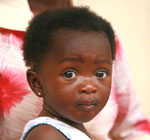 IYCN’s Wasiu “Prince” Afolabi shares the latest on Nigeria’s interpretation of the November 2009 Rapid advice: revised WHO principles and recommendations on infant feeding in the context of HIV. After much debate and examination, nutrition and prevention of mother-to-child transmission (PMTCT) of HIV stakeholders reached a national consensus in May 2010, to adopt the new guidelines. The decision, he says, is a major step toward increasing HIV-free survival for children.
IYCN’s Wasiu “Prince” Afolabi shares the latest on Nigeria’s interpretation of the November 2009 Rapid advice: revised WHO principles and recommendations on infant feeding in the context of HIV. After much debate and examination, nutrition and prevention of mother-to-child transmission (PMTCT) of HIV stakeholders reached a national consensus in May 2010, to adopt the new guidelines. The decision, he says, is a major step toward increasing HIV-free survival for children.
What was Nigeria’s recent response to the new WHO recommendations?
On May 7, 2010, the government convened a national consultative meeting of nutrition and PMTCT stakeholders to reach a consensus on adopting the 2009 WHO Rapid advice on infant feeding and HIV. After reviewing and discussing the evidence, stakeholders issued a statement with recommendations to guide the country in adopting WHO’s advice. Most notably, leaders agreed to promote a national message that will protect breastfeeding: all mothers, including those who are HIV-positive, should breastfeed their infants exclusively for 6 months and introduce complementary feeding at 6 months and continue breastfeeding until 12 months.
Who worked together to reach the consensus?
A broad group of HIV and nutrition stakeholders collaborated to reach a joint decision for adopting the new guidelines. The Federal Ministry of Health’s (FMOH) National HIV/AIDS and Sexually Transmitted Disease Control Programme (NASCP) and the Nutrition Division led the discussions. Key players included the National PMTCT Task Team, UNICEF, WHO, and non-governmental organizations including the Network of People Living with HIV/AIDS in Nigeria, Peadiatrics Association of Nigeria, and the Society for Obstetrics and Gynecology of Nigeria.
On behalf of the IYCN Project, I had the privilege to attend and participate actively in all of the stakeholder meetings.
How did the stakeholders come to this decision?
The government convened a series of meetings from January through May 2010, to review the WHO Rapid Advice and what it means for the health of Nigerian children. Through these discussions, a broad group of stakeholders came to a shared understanding of the implications of the WHO advice and the need to consider adopting them within the context of our country situation. The stakeholders had many discussions on what is practical both economically and programmatically.
What were some of the challenges?
Bringing all of the different stakeholders together for the discussions was a challenge initially. At a PMTCT Task Team meeting held by NASCP in January, there were not many partners representing the nutrition community. The participants realized that there was a need to involve the nutrition stakeholders to ensure that the country reached a decision that will have a positive impact on the nutrition of children born to HIV-positive mothers and other children in Nigeria.
After the first meeting, IYCN helped to reach out to the nutrition community to create awareness on the new recommendations and the need to get together to review the Rapid Advice and participate in the national discussions. As a result, on February 1, the Nutrition Division called a meeting of nutrition partners to inform them about a report issued by the National PMTCT Task Team and also to discuss the WHO Rapid Advice and implications for nutrition and HIV-free survival of children. After the meeting, the nutrition community became more involved in the discussions and recommended holding a national consultative meeting involving a broad range of stakeholders.
What were the initial reactions to the guidelines?
At first, many stakeholders felt that the WHO recommendations should be adopted without interpreting them within the context of our own country situation. It wasn’t until after several meetings that the stakeholders came to an understanding that the guidelines were meant to be adapted for each country.
Some stakeholders were confused by particular recommendations until WHO cleared up their advice during the May 7 consultative meeting. For example, in Recommendation 2, because WHO stated that there was weak quality of the evidence on the benefits for continuing breastfeeding beyond six months, some stakeholders believed that the new recommendations advised that mothers should stop breastfeeding at six months.
There was also confusion around WHO’s new recommendation that countries should adopt one feeding option (breastfeeding or replacement feeding). After reviewing the new guidelines, many stakeholders believed that WHO still advised conducting Affordable, Feasible, Acceptable, Sustainable, and Safe (AFASS) assessments and supporting HIV-positive mothers’ choices to either breastfeed or replacement feed for the first six months. In fact, during the initial meetings, the stakeholders drafted recommendations that included promoting the option of either breastfeeding or replacement feeding if AFASS conditions were met.
After the May 7, consultative meeting and with technical assistance from WHO, the stakeholders cleared up the confusion. The final consensus recommended that the country should adopt one message supporting breastfeeding, even though some mothers may choose the other option of replacement feeding if they meet AFASS criteria.
How will the new recommendation impact children?
Many participants expressed their hope in, and commitment to, the national consensus as an important step toward improving the health and survival of mothers and children in Nigeria. Since the previous national recommendation favored reduced breastfeeding duration, I think the new recommendation will increase HIV-free survival for infants of HIV-positive mothers and improve survival of the general population of children in Nigeria.
I am proud that our nation came to a decision that protects and supports breastfeeding. With the high level of malnutrition among children under five and the low rate of exclusive breastfeeding, we need to promote consistent messages about infant feeding and ensure that optimal breastfeeding is the norm in Nigerian society. Although the country had adopted the 2006 WHO guidelines, many clinicians still encourage mothers to stop breastfeeding even before six months.
What’s next?
Participants agreed that since infant feeding practices are influenced by a wide range of groups, a comprehensive and sustained communication strategy is needed to explain these recommendations. That way, all groups will have confidence to support the recommendations. The strategy should aim to reach all key stakeholders including health professionals, academic leaders, local health staff (including those not directly involved in PMTCT or maternal and child health services), as well as communities and civil society, donors, and most importantly, pregnant women attending antenatal care and mothers.
The IYCN Project will support the FMOH to incorporate the recommendations into the various national guidelines and training curricula on infant feeding and HIV. These documents will provide the support needed to implement the recommendations in health facilities and communities across the country.
What advice would you give to colleagues in other countries?
Countries should not rush into adopting the recommendations. I encourage leaders to build a broad understanding of the guidelines among national stakeholders and make decisions based on what makes sense within the context of their own country. This can be achieved by bringing both nutrition and PMTCT colleagues together to review the evidence and interpret the international guidelines in order to reach a national consensus.
Photos: Aurelio Ayala III, Philippe Blanc
Date: Jul 9, 2010 | Category: Q&As
